Themed collection International Year of the Periodic Table: Elements for Next Generation Batteries

Metal–organic framework-derived one-dimensional porous or hollow carbon-based nanofibers for energy storage and conversion
This review summarizes the advances in the derivation of one-dimensional porous and hollow carbon nanofibers from metal–organic frameworks for energy storage and conversion.
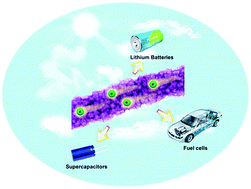
Mater. Horiz., 2018,5, 394-407
https://doi.org/10.1039/C8MH00133B
Harnessing the unique properties of 2D materials for advanced lithium–sulfur batteries
Exploring application 2D materials to enhance the electrochemical performance of lithium–sulfur batteries became an important strategy in the past decade.
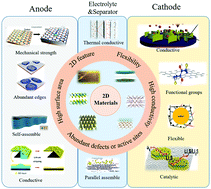
Nanoscale Horiz., 2019,4, 77-98
https://doi.org/10.1039/C8NH00170G
Layered tin sulfide and selenide anode materials for Li- and Na-ion batteries
In this review, we report the recent research progress in the area of design and synthesis of tin sulfide and selenide (SnS, SnS2, SnSe, and SnSe2) based anode materials for Li-ion batteries and Na-ion batteries.
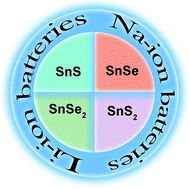
J. Mater. Chem. A, 2018,6, 12185-12214
https://doi.org/10.1039/C8TA02695E
Research progress on vanadium-based cathode materials for sodium ion batteries
In this review, we mainly overview the structures, synthesis methods and the morphology control of vanadium-based electrode materials for sodium ion batteries. In addition, the major issues, emerging challenges and some perspectives on the development of V based electrode materials for sodium ion batteries are also discussed.
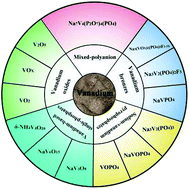
J. Mater. Chem. A, 2018,6, 8815-8838
https://doi.org/10.1039/C8TA01627E
Metal–organic framework derived hollow materials for electrochemical energy storage
The recent progress and major challenges/opportunities of MOF-derived hollow materials for energy storage are summarized in this review, particularly for lithium-ion batteries, sodium-ion batteries, lithium–Se batteries, lithium–sulfur batteries and supercapacitor applications.
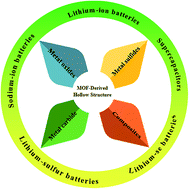
J. Mater. Chem. A, 2018,6, 6754-6771
https://doi.org/10.1039/C8TA00612A
Two-dimensional nanostructures for sodium-ion battery anodes
Two-dimensional (2D) nanostructures including 2D materials and composites containing 2D supports and active materials as sodium-ion battery anodes are reviewed.
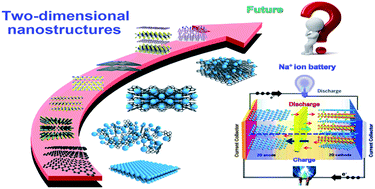
J. Mater. Chem. A, 2018,6, 3284-3303
https://doi.org/10.1039/C7TA10500B
Preparation of MoS2/TiO2 based nanocomposites for photocatalysis and rechargeable batteries: progress, challenges, and perspective
In this review, we first summarize the recent progress in MoS2/TiO2-based nanomaterials for applications in photocatalysis and rechargeable batteries.
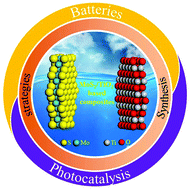
Nanoscale, 2018,10, 34-68
https://doi.org/10.1039/C7NR07366F
Enhancing potassium-ion battery performance by defect and interlayer engineering
Expanded interlayer spacing and additionally exposed edges induced by defects of MoS2 enable facile K-intercalation, rapid K-transport and promoted K-adsorption.
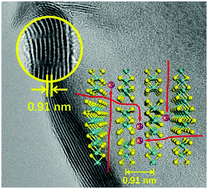
Nanoscale Horiz., 2019,4, 202-207
https://doi.org/10.1039/C8NH00305J
Fully integrated hierarchical double-shelled Co9S8@CNT nanostructures with unprecedented performance for Li–S batteries
Fully integrated hierarchical double-shelled Co9S8@CNTs have been developed as a highly efficient sulfur cathode.
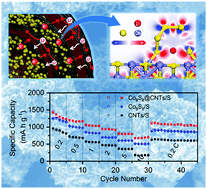
Nanoscale Horiz., 2019,4, 182-189
https://doi.org/10.1039/C8NH00289D
Tin sulfide modified separator as an efficient polysulfide trapper for stable cycling performance in Li–S batteries
Lithium–sulfur batteries (Li–S) are considered the most promising systems for next-generation energy storage devices due to their high theoretical energy density and relatively low cost.
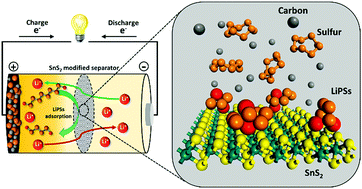
Nanoscale Horiz., 2019,4, 214-222
https://doi.org/10.1039/C8NH00172C
Surface confined titania redox couple for ultrafast energy storage
A surface confined Ti3+/Ti4+ redox couple on black TiO2 enables fast ion diffusion kinetics and provides an unprecedented rate capability.
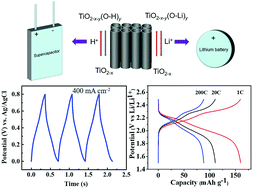
Mater. Horiz., 2018,5, 691-698
https://doi.org/10.1039/C8MH00112J
Pseudocapacitance contribution in boron-doped graphite sheets for anion storage enables high-performance sodium-ion capacitors
The high pseudocapacitance contribution in boron-doped graphite sheets for anion storage is demonstrated, and then utilized to fabricate Na-ion hybrid capacitors.
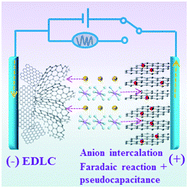
Mater. Horiz., 2018,5, 529-535
https://doi.org/10.1039/C8MH00156A
Striping modulations and strain gradients within individual particles of a cathode material upon lithiation
The insertion of Li-ions within cathode materials during the discharging of a battery oftentimes brings about one or more structural transformations. Distinct core–shell separation and striping of Li-rich and Li-poor domains are observed upon lithiation of nanowires of V2O5.
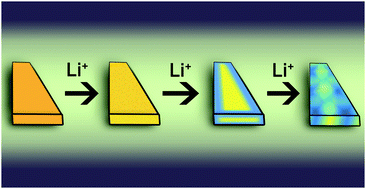
Mater. Horiz., 2018,5, 486-498
https://doi.org/10.1039/C8MH00037A
An alternative route to single ion conductivity using multi-ionic salts
Polyoligomeric silsesquioxanes with eight (LiNSO2CF3) groups can be dissolved at very high loadings into tetraglyme, forming solvent-in-salt electrolytes, and stable colloids with increasing amount of tetraglyme. Li+ ions can migrate by diffusive or coordinated hopping motions. High tLi+ and conductivities are obtained.

Mater. Horiz., 2018,5, 461-473
https://doi.org/10.1039/C7MH01130J
Direct transformation of bijels into bicontinuous composite electrolytes using a pre-mix containing lithium salt
This work demonstrates a controllable strategy for designing bicontinuous composite electrolytes.

Mater. Horiz., 2018,5, 499-505
https://doi.org/10.1039/C7MH01038A
Three-dimensional carbon network confined antimony nanoparticle anodes for high-capacity K-ion batteries
The novel 3D carbon framework confined Sb nanoparticle anode exhibits both high capacity and cycling stability.
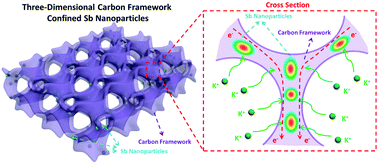
Nanoscale, 2018,10, 6820-6826
https://doi.org/10.1039/C8NR00237A
Photoinduced decoration of NiO nanosheets/Ni foam with Pd nanoparticles towards a carbon-free and self-standing cathode for a lithium–oxygen battery with a low overpotential and long cycle life
This carbon-free cathode fabricated by combining electrodeposition and photoreduction has promoted the formation of film-like Li2O2 and exhibits excellent electrochemical performances.
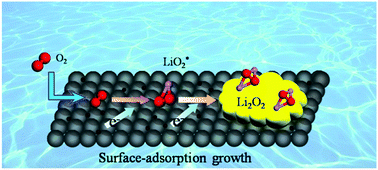
Mater. Horiz., 2018,5, 298-302
https://doi.org/10.1039/C7MH01014A
CTAB-assisted growth of self-supported Zn2GeO4 nanosheet network on a conductive foam as a binder-free electrode for long-life lithium-ion batteries
Ultrathin ZnGe2O4 NSs are fabricated on a nickel foam via a CTAB-assisted hydrothermal process.
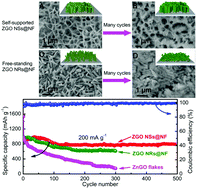
Nanoscale, 2018,10, 921-929
https://doi.org/10.1039/C7NR05407F
General oriented assembly of uniform carbon-confined metal oxide nanodots on graphene for stable and ultrafast lithium storage
A series of uniform carbon-confined metal oxide nanodots on graphene were synthesized using a nicely-designed process, which displayed stable and ultrafast lithium storage.
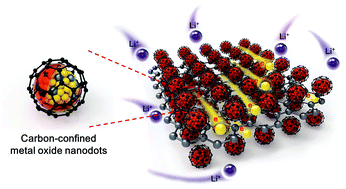
Mater. Horiz., 2018,5, 78-85
https://doi.org/10.1039/C7MH00801E
Robust N-doped carbon aerogels strongly coupled with iron–cobalt particles as efficient bifunctional catalysts for rechargeable Zn–air batteries
Porous “dual-network” N–carbon aerogel anchored FeCo particles are developed as an effective bifunctional electrocatalyst through a novel composite hydrogel strategy.
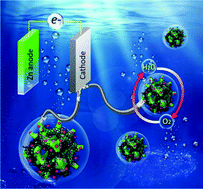
Nanoscale, 2018,10, 19937-19944
https://doi.org/10.1039/C8NR05812A
Hollow SnO2 nanospheres with oxygen vacancies entrapped by a N-doped graphene network as robust anode materials for lithium-ion batteries
Hollow SnO2 nanospheres with oxygen vacancies simultaneously wrapped by a nitrogen-doped graphene network (SnO2−x/N-rGO) improve the electrochemical performance of LIBs.
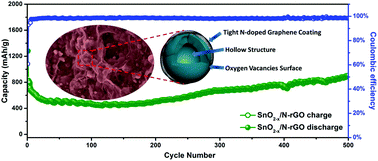
Nanoscale, 2018,10, 11460-11466
https://doi.org/10.1039/C8NR02290A
Light-weight 3D Co–N-doped hollow carbon spheres as efficient electrocatalysts for rechargeable zinc–air batteries
Facile synthesis of Co–N-doped hollow carbon spheres for rechargeable zinc–air batteries and the effect of their Co doping contents on ORR performance.
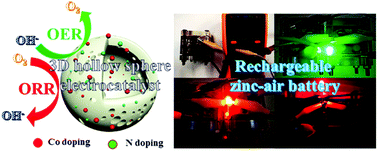
Nanoscale, 2018,10, 10412-10419
https://doi.org/10.1039/C8NR01140K
Pseudocapacitance-boosted ultrafast Na storage in a pie-like FeS@C nanohybrid as an advanced anode material for sodium-ion full batteries
A novel pie-like FeS@C nanohybrid has been prepared, which exhibits pseudocapacitance-prompted ultrafast Na storage and superior Na-ion full-cell performance.
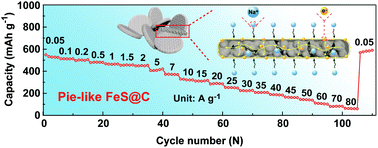
Nanoscale, 2018,10, 9218-9225
https://doi.org/10.1039/C7NR09674G
N-rich carbon coated CoSnO3 derived from in situ construction of a Co–MOF with enhanced sodium storage performance
A series of CoSnO3–NC nanobox materials with controllable carbon content were acquired by the in situ carbonization of CoSnO3–MOFs, showing a controllable N-rich carbon content range from 7.5% to 24.6%.
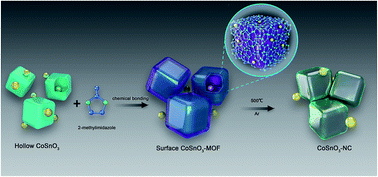
J. Mater. Chem. A, 2018,6, 4839-4847
https://doi.org/10.1039/C7TA10448K
Oxygen-deficient anatase TiO2@C nanospindles with pseudocapacitive contribution for enhancing lithium storage
Oxygen-deficient anatase TiO2@C nanospindles are realised via the hydrogenation and carbon coating of TiO2 nanospindles. The produced electrodes exhibit an enhanced electrochemical performance for Li storage.
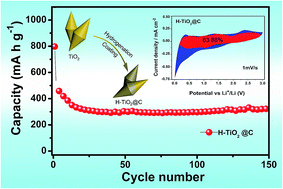
J. Mater. Chem. A, 2018,6, 4013-4022
https://doi.org/10.1039/C7TA11301C
Confinement of polysulfides within bi-functional metal–organic frameworks for high performance lithium–sulfur batteries
Cu-MOF with the dual functional binding sites is a very powerful MOF host for the inclusion of sulfur and polysulfides, demonstrating the best performance among all reported S@MOF composite cathode materials so far.

Nanoscale, 2018,10, 2774-2780
https://doi.org/10.1039/C7NR07118C
MOF-derived porous N–Co3O4@N–C nanododecahedra wrapped with reduced graphene oxide as a high capacity cathode for lithium–sulfur batteries
N–Co3O4@N–C nanododecahedra combine the advantages of strong affinity for polysulfides and excellent electronic conductivity.
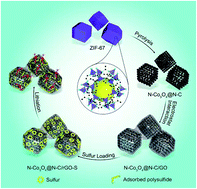
J. Mater. Chem. A, 2018,6, 2797-2807
https://doi.org/10.1039/C7TA10272K
High-yield bottom-up synthesis of 2D metal–organic frameworks and their derived ultrathin carbon nanosheets for energy storage
We report a facile and low-cost bottom-up synthesis of ultrathin Zn(bim)(OAc) MOF nanosheets (with thicknesses of ∼5 nm and a high yield of ∼65%) and their derived N-doped porous ultrathin (2.5 ± 0.8 nm) carbon nanosheets (UT-CNSs) for energy storage.
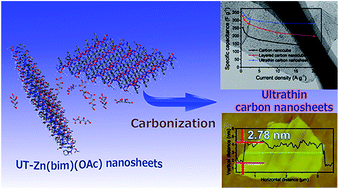
J. Mater. Chem. A, 2018,6, 2166-2175
https://doi.org/10.1039/C7TA06916B
Mesoporous layered hexagonal platelets of Co3O4 nanoparticles with (111) facets for battery applications: high performance and ultra-high rate capability
High performance battery behaviour (left panel) of mesoporous layered hexagonal platelets (middle panel) composed of highly crystalline Co3O4 nanoparticles with (111) facets (right panel) in an aqueous electrolyte of 2 M KOH.

Nanoscale, 2018,10, 1779-1787
https://doi.org/10.1039/C7NR07879J
3D interconnected porous carbon nanosheets/carbon nanotubes as a polysulfide reservoir for high performance lithium–sulfur batteries
3D interconnected porous carbon nanosheets/carbon nanotubes as the host for lithium–sulfur batteries are synthesized via a simple one-pot pyrolysis strategy.
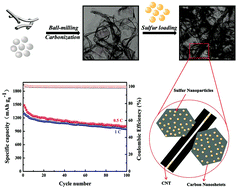
Nanoscale, 2018,10, 816-824
https://doi.org/10.1039/C7NR06805K
MoS2-covered SnS nanosheets as anode material for lithium-ion batteries with high capacity and long cycle life
A designed hierarchical nanostructure consisting of SnS nanosheets and ultrathin MoS2 nanosheets was achieved, and then evaluated as anode material for LIBs with high capacity and long cycle life.
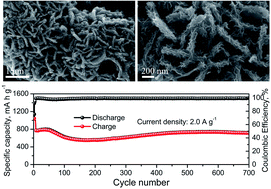
J. Mater. Chem. A, 2018,6, 592-598
https://doi.org/10.1039/C7TA08346G
Fe/Fe3C@C nanoparticles encapsulated in N-doped graphene–CNTs framework as an efficient bifunctional oxygen electrocatalyst for robust rechargeable Zn–air batteries
3d transition metals or their derivatives encapsulated in nitrogen-doped nanocarbon show promising potential in non-precious metal oxygen electrocatalysts.
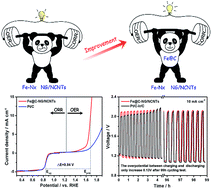
J. Mater. Chem. A, 2018,6, 516-526
https://doi.org/10.1039/C7TA08423D
About this collection
Guest edited by Zhiqun Lin, Journal of Materials Chemistry A Associate Editor, Georgia Institute of Technology, USA and Xiaodong Chen, Nanoscale Associate Editor, Nanyang Technological University, Singapore.
This themed collection is the first in a series celebrating the International Year of the Periodic Table. ‘Elements for Next Generation Batteries’ features papers from across the Materials and Nano journal porfolios, including Materials Horizons, Nanoscale Horizons, Journal of Materials Chemistry A and Nanoscale. The papers selected for this themed issue include the elements lithium, sodium, zinc, among other elements contained in new battery materials.